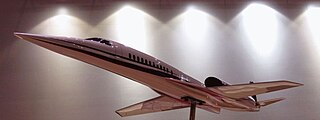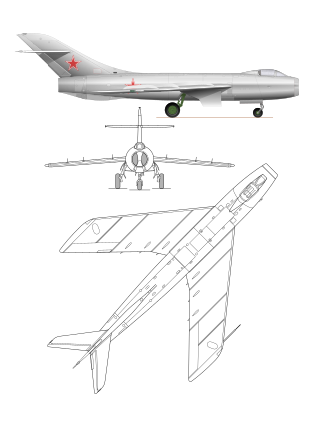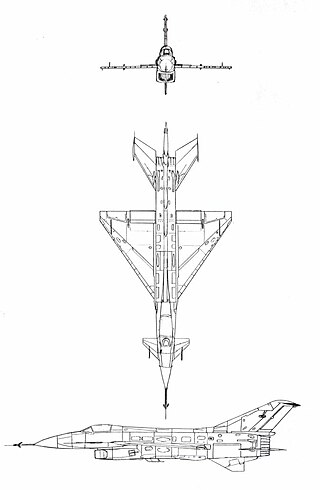
A supersonic transport (SST) or a supersonic airliner is a civilian supersonic aircraft designed to transport passengers at speeds greater than the speed of sound. To date, the only SSTs to see regular service have been Concorde and the Tupolev Tu-144. The last passenger flight of the Tu-144 was in June 1978 and it was last flown in 1999 by NASA. Concorde's last commercial flight was in October 2003, with a November 26, 2003 ferry flight being its last airborne operation. Following the permanent cessation of flying by Concorde, there are no remaining SSTs in commercial service. Several companies have each proposed a supersonic business jet, which may bring supersonic transport back again.

The Sukhoi Su-11 was an interceptor aircraft used by the Soviet Union during the Cold War.

The Sukhoi Su-47 Berkut, also designated S-32 and S-37 during initial development, was a Russian experimental supersonic jet fighter developed by the JSC Sukhoi Company. A distinguishing feature of the aircraft was its forward-swept wing which gave the aircraft excellent agility and maneuverability. While serial production of the type never materialized and the configuration was not further pursued, the sole aircraft produced served as a technology demonstrator prototype for a number of advanced technologies later used in fourth-generation fighter Su-35 and fifth-generation fighter Su-57.

The Gulfstream V is a long-range, large business jet aircraft produced by Gulfstream Aerospace, derived from the previous Gulfstream IV. It flies up to Mach 0.885, up to 51,000 feet (16,000 m) and has a 6,500 nmi (12,000 km) range. It typically accommodates four crew and 14 passengers. It first flew on November 28, 1995, and entered service in June 1997. It is used by the US military under the designation C-37A. It is followed by an improved version, the Gulfstream 550.

The Sukhoi Su-9 was a single-engine, all-weather, missile-armed interceptor aircraft developed by the Soviet Union.
The Aerion SBJ was a supersonic business jet project designed by American firm Aerion Corporation. Unveiled in 2004, the designer sought a joint venture with a business aircraft manufacturer for a $1.2–1.4 billion development in 7–8 years. Aerion received 50 letters-of-intent before enlarging the design as the Aerion AS2 in 2014. Powered by two Pratt & Whitney JT8D-219 engines, the $80 million aircraft was to transport 8–12 passengers up to Mach 1.6 and up to 4,000 nmi (7,400 km).

A supersonic business jet (SSBJ) is a business jet travelling above the speed of sound: a supersonic aircraft. Some manufacturers are designing or have been designing SSBJs, but none is currently available. Usually intended to transport about ten passengers, proposed SSBJs would be about the same size as subsonic business jets.

The Tupolev Tu-244 was a proposed supersonic transport (SST) aircraft, developed from the Tu-144. It implemented novel features such as cryogenic fuel to enable flight distances of up to 10,000 km (6,200 mi) and would have carried up to 300 passengers. The project was cancelled in 1993.

The Sukhoi Su-17 was a prototype Soviet fighter. The name was later reused for an entirely different fighter-bomber, see Sukhoi Su-17.

Yakovlev Yak-50 was an early experimental turbojet interceptor aircraft designed in 1948 by the Yakovlev OKB in the USSR. The aircraft was essentially a stretched version of the Yakovlev Yak-30 (1948), with a more powerful engine and greater wing sweep. The Yak-50 is perhaps most significant as the first Yakovlev aircraft equipped with velosipednoye (bicycle) landing gear, a trademark of later Yakovlev designs. The Yak-50 designation was later reused for a propeller-driven aerobatic and trainer aircraft.

The Reaction Engines Limited LAPCAT Configuration A2 is a design study for a hypersonic speed jet airliner intended to provide long range, high capacity commercial transportation.

The Gulfstream G650 is a large business jet produced by Gulfstream Aerospace. The model is designated Gulfstream GVI in its type certificate. The aircraft can be configured to carry from 11 to 18 passengers over a range of 7,000 nautical miles [nmi] at a top speed of Mach 0.925. The aircraft is powered by two Rolls-Royce BR725 turbofans, mounted on the rear fuselage. Gulfstream began the G650 program in 2005 and revealed it to the public in 2008. The G650ER is an extended-range version of the G650, adding about 500 nmi by modifying the fuel system, an upgrade offered for existing G650 aircraft.

The Gulfstream G400, G500, and G600 (GVII) are twin-engine business jets designed and produced by Gulfstream Aerospace. The aircraft are designated Gulfstream GVII-G500 and GVII-G600 in their type certificate.

The Mikoyan-Gurevich Ye-8 was a supersonic jet fighter developed in the Soviet Union, intended to replace the MiG-21. Only two prototypes were built in 1960–61. The original MiG-21's air intakes were moved under the fuselage, freeing up the nose where a larger and more powerful radar, able to deliver longer range air-to-air missiles, could be built in. Canards were built to both sides of the nose, in front of the cockpit,.
The Yakovlev Yak-77 was a planned large business or regional commuter jet. Work began in 1992, but no prototype was ever produced.

The Bombardier Global 7500 and Global 8000 are ultra long-range business jets developed by Bombardier Aviation and remain the largest business jets in the world. Announced in October 2010, the program was delayed by two years due to a wing redesign. The 7500, originally named the 7000, made its first flight on November 4, 2016, was type certified by Transport Canada on September 28, 2018, and entered service on 20 December 2018.

The Cessna Citation Sovereign is an American business jet developed by Cessna, part of the Cessna Citation family. Announced at the 1998 NBAA convention, the Model 680 made its maiden flight in February 2002, certification was awarded on June 2, 2004, and deliveries began in late September. The Citation Excel fuselage was stretched and joined with an all-new, larger wing and more powerful Pratt & Whitney Canada PW306C engines for increased maximum takeoff weight and a 3,200 nmi (5,900 km) range. The improved Sovereign+ was announced at the October 2012 NBAA for a first flight in April 2013 and deliveries in December, with added winglets and an improved flight deck and engines.

The Gulfstream G280 is a twin-engine business jet built by Israel Aerospace Industries (IAI) for Gulfstream Aerospace. It began delivery to users in 2012.

The Spike S-512 is a projected supersonic business jet, designed by Spike Aerospace, an American aerospace manufacturer firm based in Boston, Massachusetts.

The Aerion AS2 was a proposed supersonic business jet that was being developed by Aerion Corporation. In May 2014, it was announced that the Aerion AS2 would be part of a larger Aerion SBJ redesign, which aimed for release after a seven-year developmental period. Aerion partnered with Airbus in September the same year. In December 2017, Airbus was replaced by Lockheed Martin. Its General Electric Affinity engine was unveiled in October 2018. In February 2019, Boeing replaced Lockheed Martin. Development stopped when Aerion ceased operations in May 2021.



















